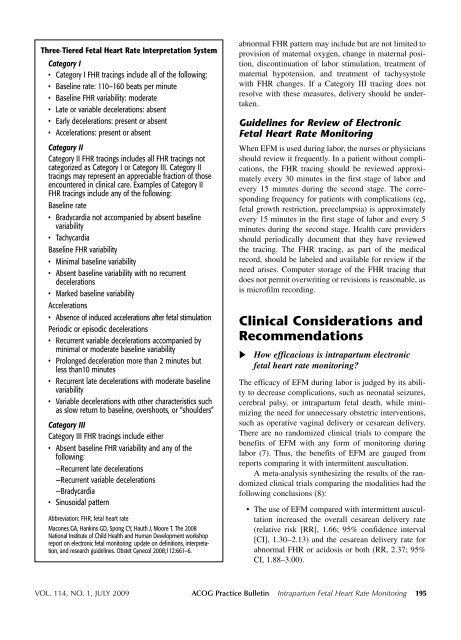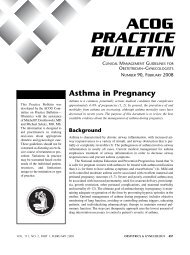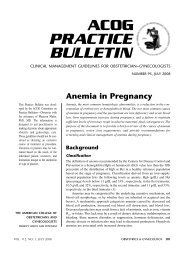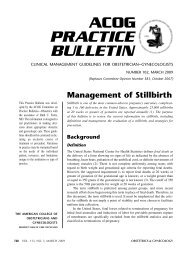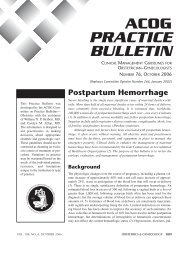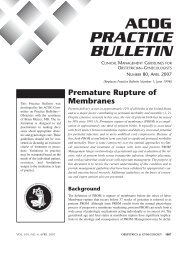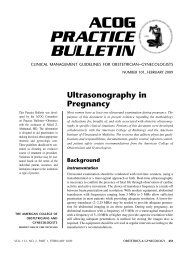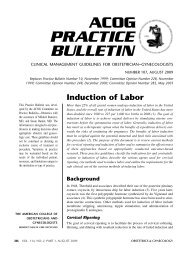Three-Tiered <strong>Fetal</strong> <strong>Heart</strong> Rate Interpretation SystemCategory I• Category I FHR tracings include all of the following:• Baseline <strong>rate</strong>: 110–160 beats per minute• Baseline FHR variability: mode<strong>rate</strong>• Late or variable decelerations: absent• Early decelerations: present or absent• Accelerations: present or absentCategory IICategory II FHR tracings includes all FHR tracings notcategorized as Category I or Category III. Category IItracings may represent an appreciable fraction of thoseencountered in clinical care. Examples of Category IIFHR tracings include any of the following:Baseline <strong>rate</strong>• Bradycardia not accompanied by absent baselinevariability• TachycardiaBaseline FHR variability• Minimal baseline variability• Absent baseline variability with no recurrentdecelerations• Marked baseline variabilityAccelerations• Absence of induced accelerations after fetal stimulationPeriodic or episodic decelerations• Recurrent variable decelerations accompanied byminimal or mode<strong>rate</strong> baseline variability• Prolonged deceleration more than 2 minutes butless than10 minutes• Recurrent late decelerations with mode<strong>rate</strong> baselinevariability• Variable decelerations with other characteristics suchas slow return to baseline, overshoots, or “shoulders”Category IIICategory III FHR tracings include either• Absent baseline FHR variability and any of thefollowing:—Recurrent late decelerations—Recurrent variable decelerations—Bradycardia• Sinusoidal patternAbbreviation: FHR, fetal heart <strong>rate</strong>Macones GA, Hankins GD, Spong CY, Hauth J, Moore T. The 2008National Institute of Child Health and Human Development workshopreport on electronic fetal monitoring: update on definitions, interpretation,and research guidelines. Obstet Gynecol 2008;112:661–6.abnormal FHR pattern may include but are not limited toprovision of maternal oxygen, change in maternal position,discontinuation of labor stimulation, treatment ofmaternal hypotension, and treatment of tachysystolewith FHR changes. If a Category III tracing does notresolve with these measures, delivery should be undertaken.Guidelines for Review of Electronic<strong>Fetal</strong> <strong>Heart</strong> Rate <strong>Monitoring</strong>When EFM is used during labor, the nurses or physiciansshould review it frequently. In a patient without complications,the FHR tracing should be reviewed approximatelyevery 30 minutes in the first stage of labor andevery 15 minutes during the second stage. The correspondingfrequency for patients with complications (eg,fetal growth restriction, preeclampsia) is approximatelyevery 15 minutes in the first stage of labor and every 5minutes during the second stage. Health care providersshould periodically document that they have reviewedthe tracing. The FHR tracing, as part of the medicalrecord, should be labeled and available for review if theneed arises. Computer storage of the FHR tracing thatdoes not permit overwriting or revisions is reasonable, asis microfilm recording.Clinical Considerations andRecommendationsHow efficacious is intrapartum electronicfetal heart <strong>rate</strong> monitoring?The efficacy of EFM during labor is judged by its abilityto decrease complications, such as neonatal seizures,cerebral palsy, or intrapartum fetal death, while minimizingthe need for unnecessary obstetric interventions,such as operative vaginal delivery or cesarean delivery.There are no randomized clinical trials to compare thebenefits of EFM with any form of monitoring duringlabor (7). Thus, the benefits of EFM are gauged fromreports comparing it with intermittent auscultation.A meta-analysis synthesizing the results of the randomizedclinical trials comparing the modalities had thefollowing conclusions (8):• The use of EFM compared with intermittent auscultationincreased the overall cesarean delivery <strong>rate</strong>(relative risk [RR], 1.66; 95% confidence interval[CI], 1.30–2.13) and the cesarean delivery <strong>rate</strong> forabnormal FHR or acidosis or both (RR, 2.37; 95%CI, 1.88–3.00).VOL. 114, NO. 1, JULY 2009 <strong>ACOG</strong> <strong>Practice</strong> <strong>Bulletin</strong> <strong>Intrapartum</strong> <strong>Fetal</strong> <strong>Heart</strong> Rate <strong>Monitoring</strong> 195
• The use of EFM increased the risk of both vacuumand forceps operative vaginal delivery (RR, 1.16;95% CI, 1.01–1.32).• The use of EFM did not reduce perinatal mortality(RR, 0.85; 95% CI, 0.59–1.23).• The use of EFM reduced the risk of neonatal seizures(RR, 0.50; 95% CI, 0.31–0.80).• The use of EFM did not reduce the risk of cerebralpalsy (RR, 1.74; 95% CI, 0.97–3.11).There is an unrealistic expectation that a nonreassuringFHR tracing is predictive of cerebral palsy. Thepositive predictive value of a nonreassuring pattern topredict cerebral palsy among singleton newborns withbirth weights of 2,500 g or more is 0.14%, meaning thatout of 1,000 fetuses with a nonreassuring FHR pattern,only one or two will develop cerebral palsy (9). The falsepositive<strong>rate</strong> of EFM for predicting cerebral palsy isextremely high, at greater than 99%.Available data, although limited in quantity, suggestthat the use of EFM does not result in a reduction in cerebralpalsy (8). This is consistent with data that suggestthat the occurrence of cerebral palsy has been stable overtime, despite the widespread introduction of EFM (10).The principal explanation for why the prevalence ofcerebral palsy has not diminished despite the use of EFMis that 70% of cases occur before the onset of labor; only4% of cases of encephalopathy can be attributed solelyto intrapartum events (11, 12).Given that the available data do not show a clearbenefit for the use of EFM over intermittent auscultation,either option is acceptable in a patient without complications.Logistically, it may not be feasible to adhere toguidelines for how frequently the heart <strong>rate</strong> should beauscultated. One prospective study noted that the protocolfor intermittent auscultation was successfully completedin only 3% of the cases (13). The most commonreasons for unsuccessful intermittent auscultationincluded the frequency of recording and the requirementsfor recording.Intermittent auscultation may not be appropriate forall pregnancies. Most of the clinical trials that compareEFM with intermittent auscultation have excluded participantsat high risk of adverse outcomes, and the relativesafety of intermittent auscultation in such cases isuncertain. The labor of women with high-risk conditions(eg, suspected fetal growth restriction, preeclampsia, andtype 1 diabetes) should be monitored with continuousFHR monitoring.There are no comparative data indicating the optimalfrequency at which intermittent auscultation shouldbe performed in the absence of risk factors. One methodis to evaluate and record the FHR at least every 15 minutesin the active phase of the first stage of labor and atleast every 5 minutes in the second stage (14).What is the interobserver and intraobservervariability of intrapartum electronic fetalheart <strong>rate</strong> monitoring assessment?There is high interobserver and intraobserver variabilityin the interpretation of FHR tracings. For example, whenfour obstetricians examined 50 cardiotocograms, theyagreed in only 22% of the cases (15). Two months later,during the second review of the same 50 tracings, the cliniciansinterpreted 21% of the tracings differently thanthey did during the first evaluation. In another study, fiveobstetricians independently interpreted 150 cardiotocograms(16). The obstetricians interpreted the tracingssimilarly in 29% of the cases, suggesting poor interobserverreliability.The interpretation of cardiotocograms is more consistentwhen the tracing is normal (17). With retrospectivereviews, the foreknowledge of neonatal outcome mayalter the reviewer’s impressions of the tracing. Given thesame intrapartum tracing, a reviewer is more likely tofind evidence of fetal hypoxia and criticize the obstetrician’smanagement if the outcome was poor versus good(18). Therefore, reinterpretation of the FHR tracing,especially if neonatal outcome is known, may not bereliable.When should the very preterm fetus bemonitored?The decision to monitor the very preterm fetus requiresa discussion between the obstetrician, pediatrician, andpatient concerning the likelihood of survival or severemorbidity of the preterm child (based on gestational age,estimated fetal weight, and other factors) and issuesrelated to mode of delivery. If a patient undergoes acesarean delivery for indications related to a pretermfetus, continuous monitoring should be used rather thanintermittent auscultation. The earliest gestational agethat this will occur may vary.Nonreassuring FHR patterns may occur with up to60% of women with preterm labor, with the most commonabnormality being deceleration and bradycardia,followed by tachycardia and minimal or absent baselinevariability (19). Variable decelerations are more commonamong preterm (55–70%) deliveries than term(20–30%) deliveries (20). If FHR abnormalities are persistent,intrauterine resuscitation, ancillary tests toensure fetal well-being, and possibly delivery should beundertaken (21).196 <strong>ACOG</strong> <strong>Practice</strong> <strong>Bulletin</strong> <strong>Intrapartum</strong> <strong>Fetal</strong> <strong>Heart</strong> Rate <strong>Monitoring</strong> OBSTETRICS & GYNECOLOGY


